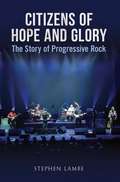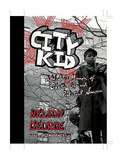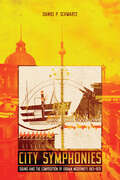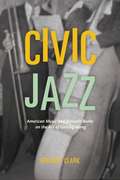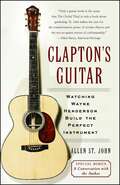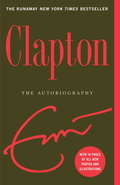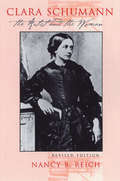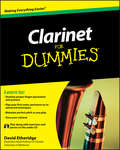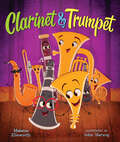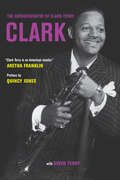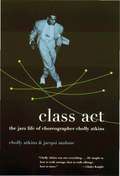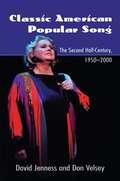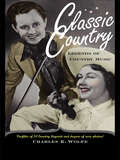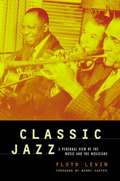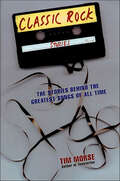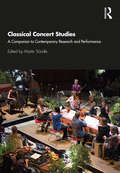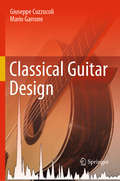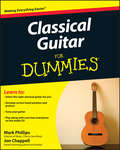- Table View
- List View
Citizens of Hope and Glory: The Story of Progressive Rock
by Stephen LambeCreated in the late 1960s, fashionable in the early 1970s and hated in the 1980s, Progressive Rock has a colourful and eventful story. Many of the genre's main protagonists, including Genesis, Yes, King Crimson and Emerson, Lake & Palmer, remain as popular as ever, while lesser-known names like Camel, Caravan, Renaissance, Van der Graaf Generator and Gentle Giant retain cult status. Prog expert Stephen Lambe guides the reader through the early years as the music developed out of the British Progressive Music boom of the late 1960s into its own genre, and reached full maturity in the early 1970s. He also discusses how the music was received and developed outside the UK, particularly in the USA, Italy and the Scandinavian countries. Received wisdom has it that punk swept Progressive Rock away in the late 1970s, yet the genre never died. An early 1980s revival, spearheaded by major label signings Marillion, IQ and Pallas, burned brightly but fell away sharply later in the decade. However, in the early 1990s, the movement began to re-establish itself, largely below the radar, led by Swedish band The Flower Kings and American group Spock's Beard. The rise of the internet and the decline of the worldwide pop industry allowed niche music - as Progressive Rock had now become - to flourish once again in the new millennium.
City Kid
by Nelson GeorgeA candid, colorful memoir about a nerd from the Brooklyn projects who made it big Nelson George grew up in the Tilden housing project in the crime- and despair-ridden Brownsville section of Brooklyn during the 1960s and 70s. In this tough neighborhood, Nelson was the nerdy kid who, in between stickball and street games, devoured Captain America comics, Ernest Hemingway novels, and album liner notes. City Kidintroduces us to Nelson's family: his absent wanna-be-hustler father; his tough-minded sister, who is seduced by the streets; and his mother, who dreams of becoming a teacher and returning to the South. Amid the struggles of his family, Nelson finds himself drawn into the world of black pop culture, first as a writer and then as a filmmaker, eventually collaborating with some of the major figures of the era-Spike Lee, Russell Simmons, Chris Rock, and many others. Nelson's story is ultimately one of triumph, but it is not saccharine, sentimental, or full of false inspiration. Seeking transcendence through art and loving New York City, Nelson creates an insightful portrait of the emergence of black artists in the 1980s and 90s and illuminates how the pain of life can be turned into thoughtful books and cinema.
City Symphonies: Sound and the Composition of Urban Modernity, 1913–1931
by Daniel P. SchwartzCinema scholars categorize city symphony films of the 1920s and early 1930s as a subgenre of the silent film. Defined in visual terms, the city symphony organizes the visible elements of urban experience according to musical principles such as rhythm and counterpoint.In City Symphonies Daniel Schwartz explores the unheard sonic dimensions of these ostensibly silent films. The book turns its ear to the city symphony as an audible phenomenon, one that encompasses a multitude of works beyond the cinema, such as musical compositions, mass spectacles, radio experiments, and even paintings. What these works have in common is their treatment of the city as a medium for sound. The city is neither background nor content; rather, it is the material through which avant-garde works express themselves. In resonating through the city, these multimedia pieces perform experiments that undermine the borders between sight and sound.Applying an interdisciplinary approach, City Symphonies expands our understanding of the genre, breaking out of the confines of the cinema and onto the street.
Civic Jazz: American Music and Kenneth Burke on the Art of Getting Along
by Gregory ClarkJazz is born of collaboration, improvisation, and listening. In much the same way, the American democratic experience is rooted in the interaction of individuals. It is these two seemingly disparate, but ultimately thoroughly American, conceits that Gregory Clark examines in Civic Jazz. Melding Kenneth Burke’s concept of rhetorical communication and jazz music’s aesthetic encounters with a rigorous sort of democracy, this book weaves an innovative argument about how individuals can preserve and improve civic life in a democratic culture. Jazz music, Clark argues, demonstrates how this aesthetic rhetoric of identification can bind people together through their shared experience in a common project. While such shared experience does not demand agreement--indeed, it often has an air of competition--it does align people in practical effort and purpose. Similarly, Clark shows, Burke considered Americans inhabitants of a persistently rhetorical situation, in which each must choose constantly to identify with some and separate from others. Thought-provoking and path-breaking, Clark’s harmonic mashup of music and rhetoric will appeal to scholars across disciplines as diverse as political science, performance studies, musicology, and literary criticism.
Civic Jazz: American Music and Kenneth Burke on the Art of Getting Along
by Gregory ClarkJazz is born of collaboration, improvisation, and listening. In much the same way, the American democratic experience is rooted in the interaction of individuals. It is these two seemingly disparate, but ultimately thoroughly American, conceits that Gregory Clark examines in Civic Jazz. Melding Kenneth Burke’s concept of rhetorical communication and jazz music’s aesthetic encounters with a rigorous sort of democracy, this book weaves an innovative argument about how individuals can preserve and improve civic life in a democratic culture. Jazz music, Clark argues, demonstrates how this aesthetic rhetoric of identification can bind people together through their shared experience in a common project. While such shared experience does not demand agreement—indeed, it often has an air of competition—it does align people in practical effort and purpose. Similarly, Clark shows, Burke considered Americans inhabitants of a persistently rhetorical situation, in which each must choose constantly to identify with some and separate from others. Thought-provoking and path-breaking, Clark’s harmonic mashup of music and rhetoric will appeal to scholars across disciplines as diverse as political science, performance studies, musicology, and literary criticism.
Clap Your Hands: A Celebration of Gospel
by Toyomi IgusClap Your Hands is an inspirational, joyous celebration of poetry, art, and rhythm, tracing the history of African American gospel music and the poets, singers, and thought leaders who have fearlessly and soulfully contributed to the spiritual and social evolution of America. This powerful and poetic read bursts with vibrant artwork and is rich in personal notes and information that will interest any history buff or music enthusiast.Created by the dynamic author and illustrator team of Toyomi Igus and Michele Wood, winners of the Coretta Scott King Award for I See the Rhythm, Clap Your Hands shares the Black history behind gospel music that has courageously broken all color barriers, influencing both worship and popular culture in America for hundreds of years. Clap Your Hands is great for children ages 4 to 8. Inside, you&’ll find:Notes from the author and the illustrator sharing their personal inspirations and influences, as well as their research on the roots and evolution of gospel musicHistorical notes about the events covered in the book, exploring the cultural importance of gospel music throughout historyFurther reading section, discography, and discussion questions to encourage learning and engagementA running timeline of all historical milestones—from the first slaves to President Obama&’s inaugurationReaders of all ages will be captivated by this informative and inspirational blend of poetry, art, and music that honors gospel music and reflects its journey.
Clapton's Guitar: Watching Wayne Henderson Build the Perfect Instrument
by Allen St. JohnNew York Times bestselling author Allen St. John started off looking for the world&’s greatest guitar, but what he found instead was the world&’s greatest guitar builder.Living and working in Rugby, Virginia (population 7), retired rural mail carrier Wayne Henderson is a true American original, making America's finest instruments using little more than a pile of good wood and a sharp whittling knife. There's a 10-year waiting list for Henderson's heirloom acoustic guitars—and even a musical legend like Eric Clapton must wait his turn. Partly out of self-interest, St. John prods Henderson into finally building Clapton's guitar, and soon we get to pull up a dusty stool and watch this Stradivari in glue-stained blue jeans work his magic. The story that ensues will captivate you with its portrait of a world where craftsmanship counts more than commerce, and time is measured by old jokes, old-time music, and homemade lemon pies shared by good friends.
Clapton: The Autobiography
by Eric Clapton“I found a pattern in my behavior that had been repeating itself for years, decades even. Bad choices were my specialty, and if something honest and decent came along, I would shun it or run the other way.”<P><P> With striking intimacy and candor, Eric Clapton tells the story of his eventful and inspiring life in this poignant and honest autobiography. More than a rock star, he is an icon, a living embodiment of the history of rock music. Well known for his reserve in a profession marked by self-promotion, flamboyance, and spin, he now chronicles, for the first time, his remarkable personal and professional journeys. <P> Born illegitimate in 1945 and raised by his grandparents, Eric never knew his father and, until the age of nine, believed his actual mother to be his sister. In his early teens his solace was the guitar, and his incredible talent would make him a cult hero in the clubs of Britain and inspire devoted fans to scrawl “Clapton is God” on the walls of London’s Underground. With the formation of Cream, the world's first supergroup, he became a worldwide superstar, but conflicting personalities tore the band apart within two years. His stints in Blind Faith, in Delaney and Bonnie and Friends, and in Derek and the Dominos were also short-lived but yielded some of the most enduring songs in history, including the classic “Layla.” <P> During the late sixties he played as a guest with Jimi Hendrix and Bob Dylan, as well as the Beatles, the Rolling Stones, and longtime friend George Harrison. It was while working with the latter that he fell for George’s wife, Pattie Boyd, a seemingly unrequited love that led him to the depths of despair, self-imposed seclusion, and drug addiction. By the early seventies he had overcome his addiction and released the bestselling album 461 Ocean Boulevard, with its massive hit “I Shot the Sheriff.” He followed that with the platinum album Slowhand, which included “Wonderful Tonight,” the touching love song to Pattie, whom he finally married at the end of 1979. A short time later, however, Eric had replaced heroin with alcohol as his preferred vice, following a pattern of behavior that not only was detrimental to his music but contributed to the eventual breakup of his marriage. <P> In the eighties he would battle and begin his recovery from alcoholism and become a father. But just as his life was coming together, he was struck by a terrible blow: His beloved four-year-old son, Conor, died in a freak accident. At an earlier time Eric might have coped with this tragedy by fleeing into a world of addiction. But now a much stronger man, he took refuge in music, responding with the achingly beautiful “Tears in Heaven.”<P> Clapton is the powerfully written story of a survivor, a man who has achieved the pinnacle of success despite extraordinary demons. It is one of the most compelling memoirs of our time. <P><b>A New York Times Bestseller</b>
Clara Schumann Piano Music (Dover Classical Piano Music)
by Clara SchumannOriginal compilation of the composer's most popular, most mature piano works, including Witches Dance, Op. 5, No. 1; Four Fleeting Pieces, Op. 15; Three Preludes and Fugues, Op. 16; Variations on a Theme by Robert Schumann, Op. 20; Romance, Op. 11, No. 2; and Three Romances, Op. 21. Selected and with an Introduction by Dr. Nancy B. Reich.
Clara Schumann Studies (Cambridge Composer Studies)
by Joe DaviesSince the 1980s, when she re-emerged from the peripheries into a more central position in music studies, Clara Schumann (1819–1896) has exerted an enduring fascination over the scholarly and popular imagination. Revisionist biographies, the uncovering of primary sources (diaries, letters, memorabilia), and filmic and literary depictions of Schumann have all brought into sharper focus the details and reception of her life, while simultaneously drawing attention to how much there is still to learn about her creativity. This book brings together a team of leading scholars to reappraise Clara Schumann in three particular respects: first, by delving deeper into her social and musical contexts; secondly, by offering fresh analytical perspectives on her songs and instrumental music; and thirdly, by reconsidering her legacy as a pianist and teacher. In doing so, the volume not only contributes to a rounded picture of Schumann's creative vision, but also opens up new pathways in the wider study of women in music.
Clara Schumann: The Artist and the Woman
by Nancy B. ReichThis absorbing and award-winning biography tells the story of the tragedies and triumphs of Clara Wieck Schumann (1819-1896), a musician of remarkable achievements. At once artist, composer, editor, teacher, wife, and mother of eight children, she was an important force in the musical world of her time. To show how Schumann surmounted the obstacles facing female artists in the nineteenth century, Nancy B. Reich has drawn on previously unexplored primary sources: unpublished diaries, letters, and family papers, as well as concert programs. Going beyond the familiar legends of the Schumann literature, she applies the tools of musicological scholarship and the insights of psychology to provide a new, full-scale portrait.The book is divided into two parts. In Part One, Reich follows Clara Schumann's life from her early years as a child prodigy through her marriage to Robert Schumann and into the forty years after his death, when she established and maintained an extraordinary European career while supporting and supervising a household and seven children. Part Two covers four major themes in Schumann's life: her relationship with Johannes Brahms and other friends and contemporaries; her creative work; her life on the concert stage; and her success as a teacher.Throughout, excerpts from diaries and letters in Reich's own translations clear up misconceptions about her life and achievements and her partnership with Robert Schumann. Highlighting aspects of Clara Schumann's personality and character that have been neglected by earlier biographers, this candid and eminently readable account adds appreciably to our understanding of a fascinating artist and woman.For this revised edition, Reich has added several photographs and updated the text to include recent discoveries. She has also prepared a Catalogue of Works that includes all of Clara Schumann's known published and unpublished compositions and works she edited, as well as descriptions of the autographs, the first editions, the modern editions, and recent literature on each piece. The Catalogue also notes Schumann's performances of her own music and provides pertinent quotations from letters, diaries, and contemporary reviews.
Clarinet For Dummies
by David EtheridgeMaster the most popular woodwind Want to play the clarinet? No problem! This hands-on guide teaches you all the fundamental techniques you need to play this popular woodwind alone or in a group setting. Clarinet For Dummies gives you the ideal introduction to play clarinet. You?ll begin by learning how to properly hold a clarinet and move on to getting a consistent sound, reading music, and playing songs in a variety of styles, including classical, pop, and jazz. Step-by-step instruction on finger placement, posture, and basic up-keep for the instrument Tips on how to buy or rent a clarinet Accompanying CD offers play-along recordings of every exercise featured in the book Whether you?ve never held a clarinet or are looking to brush up on skills from your youth, Clarinet For Dummies is packed with friendly, easy-to-follow instructions to have you playing this versatile instrument with ease! Note: CD-ROM/DVD and other supplementary materials are not included as part of eBook file.
Clarinet and Trumpet
by Melanie EllsworthA charming and funny picture book featuring the harmonious friendship between Clarinet and Trumpet. But what happens when their friendship falls flat? Perfect for fans of Stick & Stone and Spoon.
Clark: The Autobiography of Clark Terry
by Bill Cosby Quincy Jones Clark Terry Gwen TerryCompelling from cover to cover, this is the story of one of the most recorded and beloved jazz trumpeters of all time. With unsparing honesty and a superb eye for detail, Clark Terry, born in 1920, takes us from his impoverished childhood in St. Louis, Missouri, where jazz could be heard everywhere, to the smoke-filled small clubs and carnivals across the Jim Crow South where he got his start, and on to worldwide acclaim. Terry takes us behind the scenes of jazz history as he introduces scores of legendary greats--Ella Fitzgerald, Oscar Peterson, Dizzy Gillespie, Dinah Washington, Doc Severinsen, Ray Charles, Thelonious Monk, Billie Holiday, Sarah Vaughan, Coleman Hawkins, Zoot Sims, and Dianne Reeves, among many others. Terry also reveals much about his own personal life, his experiences with racism, how he helped break the color barrier in 1960 when he joined the Tonight Show band on NBC, and why--at ninety years old--his students from around the world still call and visit him for lessons.
Class Act: The Jazz Life of Choreographer Cholly Atkins
by Atkins Cholly Jacqui MaloneCholly Atkins's career has spanned an extraordinary era of American dance. With his partner, Honi Coles, Cholly toured the country, performing with such jazz masters as Louis Armstrong, Cab Calloway, and Count Basie. In the fifties, Cholly created the new specialization of "vocal choreography," teaching such artists as the Supremes, the Temptations, Gladys Knight and the Pips, and Marvin Gaye how to perform their music by adding rhythmical dance steps drawn from twentieth-century American dance, from the Charleston to rhythm tap. Chronicling the rise, near demise, and rediscovery of tap dancing, the book is both an engaging biography and a rich cultural history.
Class Act: The Jazz Life of Choreographer Cholly Atkins
by Jacqui Malone Cholly AtkinsCholly Atkins's career has spanned an extraordinary era of American dance. He began performing during Prohibition and continued his apprenticeship in vaudeville, in nightclubs, and in the army during World War II. With his partner, Honi Coles, Cholly toured the country, performing with such jazz masters as Louis Armstrong, Cab Calloway, and Count Basie. As tap reached a nadir in the fifties, Cholly created the new specialization of "vocal choreography," teaching rhythm-and-blues singers how to perform their music by adding rhythmical dance steps drawn from twentieth-century American dance, from the Charleston to rhythm tap. For the burgeoning Motown record label, Cholly taught such artists as the Supremes, Smokey Robinson and the Miracles, the Temptations, Gladys Knight and the Pips, and Marvin Gaye to command the stage in ways that would enhance their performances and "sell" their songs.Class Act tells of Cholly's boyhood and coming of age, his entry into the dance world of New York City, his performing triumphs and personal tragedies, and the career transformations that won him gold records and a Tony for choreographing Black and Blue on Broadway. Chronicling the rise, near demise, and rediscovery of tap dancing, the book is both an engaging biography and a rich cultural history.
Class-D Audio Power Amplifier Design
by Robert N. BuonoClass-D Audio Power Amplifier Design is a comprehensive and detailed guide to Class-D amplifiers. Including historical perspectives covering the evolution of Class-D to the present day, this book provides a detailed discussion of each Class-D functional block.With design guidance to optimize performance, the reader will learn from a series of real-life examples and design challenges to equip them in designing reliable, high-performance Class-D audio amplifiers. Featuring numerous diagrams and schematics to aid learning, chapters also cover a wide range of topics, such as: Power supply considerations EMI mitigation Multi-channel designs Gate driver circuits L-C demodulation filters. Class-D Audio Power Amplifier Design is the essential reference guide for students, researchers, and professionals engaged with audio electronics.
Classic American Popular Song: The Second Half-Century, 1950-2000
by David Jenness Donald VelseyFirst Published in 2006. Routledge is an imprint of Taylor & Francis, an informa company.
Classic Country: Legends of Country Music
by Charles K. WolfeNow for the first time, country music authority Charles K. Wolfe gathers together his profiles of 50 legends of country music, including Bill Monroe, Lefty Frizzell, and Kitty Wells.
Classic Jazz: A Personal View of the Music and the Musicians
by Floyd LevinAn award-winning jazz writer has pulled together 50 years' worth of his articles, which appeared mostly in jazz magazines, to take readers into the world of jazz and its musicians. This personal view of a rich American music weaves in anecdotal material, primary research, and music analysis into every chapter. 51 photos. 10 line illustrations.
Classic Rock Stories: The Stories Behind the Greatest Songs of All Time
by Tim MorseThe first time on the open road with Dad's beat-up clunker and a brand-new driver's lecense. That first kiss. Practicing Steve Tyler moves in the garage. Lazy summer days with nothing to do but hang out with a group of friends and the radio. Classic Rock. In Classic Rock Stories, classic rockers reveal the sometimes painful, sometimes accidental, and often hilarious process of creating the songs that you can still sing aloud. In their own words, rockers like Pete Townshend, John Lennon, Stevie Nicks, Elton John, and Keith Richards tell about the drugs, the pain, the love gone bad, and the accidents that resulted in the hits.
Classical Concert Studies: A Companion to Contemporary Research and Performance
by Martin TröndleClassical Concert Studies: A Companion to Contemporary Research and Performance is a landmark publication that maps out a new interdisciplinary field of Concert Studies, offering fresh ways of understanding the classical music concert in the twenty-first century. It brings together essays, research articles, and case studies from scholars and music professionals including musicians, music managers, and concert designers. Gathering both historical and contemporary cases, the contributors draw on approaches from sociology, ethnology, musicology, cultural studies, and other disciplines to create a rich portrait of the classical concert’s past, present, and future. Based on two earlier volumes published in German under the title Das Konzert (The Concert), and with a selection of new chapters written for the English edition, this companion enables students, researchers, and practitioners in the classical and contemporary music fields to understand this emerging field of research, go beyond traditional disciplinary boundaries and methodologies, and spark a renaissance for the classical concert.
Classical Concert Studies: A Companion to Contemporary Research and Performance
by Martin TröndleClassical Concert Studies: A Companion to Contemporary Research and Performance is a landmark publication that maps out a new interdisciplinary field of Concert Studies, offering fresh ways of understanding the classical music concert in the twenty-first century. It brings together essays, research articles, and case studies from scholars and music professionals including musicians, music managers, and concert designers. Gathering both historical and contemporary cases, the contributors draw on approaches from sociology, ethnology, musicology, cultural studies, and other disciplines to create a rich portrait of the classical concert’s past, present, and future.Based on two earlier volumes published in German under the title Das Konzert (The Concert), and with a selection of new chapters written for the English edition, this companion enables students, researchers, and practitioners in the classical and contemporary music fields to understand this emerging field of research, go beyond traditional disciplinary boundaries and methodologies, and spark a renaissance for the classical concert.
Classical Guitar Design
by Giuseppe Cuzzucoli Mario GarroneThis book describes the entire process of designing guitars, including the theory and guidelines for implementing it in practice. It discusses areas from acoustics and resonators to new tools and how they assist traditional construction techniques. The book begins by discussing the fundamentals of the sounds of a guitar, strings, and oscillating systems. It then moves on to resonators and acoustics within the guitar, explaining the analysis systems and evaluation methods, and comparing classic and modern techniques. Each area of the guitar is covered, from the soundboard and the back, to the process of closing the instrument. The book concludes with an analysis of historic and modern guitars. This book is of interest to luthiers wanting to advance their practice, guitar players wishing to learn more about their instruments, and academics in engineering and physics curious about the principles of acoustics when applied to musical instruments.
Classical Guitar For Dummies
by Mark Phillips Jon ChappellWant to be a classical guitarist but never had a lesson?Want to be a classical guitarist, but never had a lesson? No problem -- this hands-on guide teaches you all the fundamental techniques you need to play scales, melodies, and full-length pieces in the classical style. You get plenty of practice exercises to stretch your skills, selections from the classical repertoire, and a bonus audio CD that helps you play along with the music pieces from the book!Get acquainted with your guitar -- familiarize yourself with the unique make-up and parts of a classical guitarStart making some music -- play melodies on individual strings, move on to arpeggios, and get your fingers in shape with scalesRamp up your technique -- play barres, slurs, and trills; handle harmonics; master right-hand tremolo; and venture up the neck to play in the higher positionsBuild your classical repertoire -- from Renaissance and Baroque to Classical, Romantic, and Modern, play pieces from the major eras in classical musicPractice makes perfect -- improve your performance with expert guidance through each exercise and piece in the bookOpen the book and find:Tips and techniques for playing beautiful piecesHow to read music notation and tablatureBasic finger and thumb strokesRight- and left-hand techniquesMusical examples, charts, and photosMusic pieces from the guitar greatsThe best ways to care for your guitarA step-by-step tutorial on changing your stringsBonus CD IncludesMore than 140 recorded performances of the exercises and pieces featured in the bookPieces performed using a count-off, allowing you to play along in time with the musicTuning notes to help you tune up your guitarNote: CD-ROM/DVD and other supplementary materials are not included as part of eBook file.
